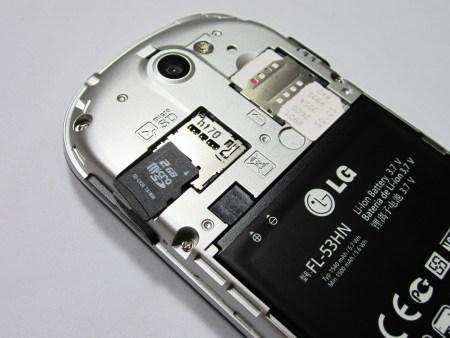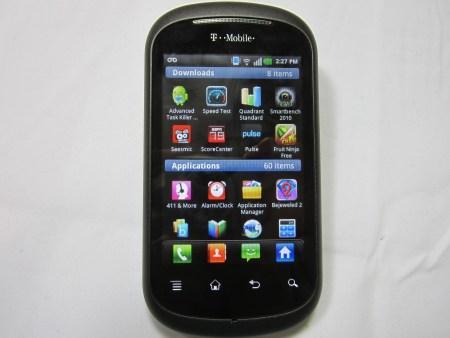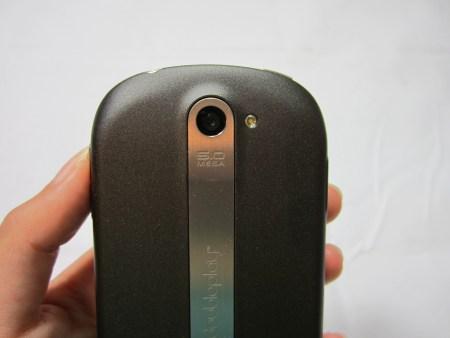I've heard a lot of people complain that all smartphones these days look alike. 'They're all the same', they say. 'Just a flat square panel with a touchscreen on it.' Well, here's something different for you: a phone with two screens, one of them built into the also-included physical QWERTY. How's that for originality? Yes, we've seen this idea before and yes, it wasn't very popular. But I think LG is on to something here. Android is supposedly the only OS with true multi-tasking, but no matter how well it's designed you can still only do one thing at a time. What if you could literally do two things at once? What if you could check your e-mail and respond to a message while watching a video? Or upload a video while recording another one? Or take notes on a notepad while reading a web page? Sounds pretty cool, right? Well, that's the power that the DoublePlay brings.
The downside is that this is not the most capable or well-designed device overall. It's a shame that this dual-screen technology wasn't used on a more impressive device. Otherwise, it would be the must-have phone of the year (or at least until another Android phone came out the next week). Still, it has some awesome technology and a decent spec sheet. Is the DoublePlay worth a look?
I'll just come out and say it. Aesthetically, the DoublePlay isn't going to win any prizes. It's short and portly and seems to weigh a ton. The physical keyboard already adds some bulk but the extra display on that keyboard adds even more. Coming in at 4.8-inches by 2.5-inches by .63-inches and weighing 6.7 ounces, you're going to notice this device in your hand, pocket, or purse. The rather bland color scheme and cheap-feeling hardware doesn't help. So, there's that.
But maybe you like the hardware design. Who knows? It's all personal. I'm just saying it doesn't feel like you're holding a device with some revolutionary technology inside of it when in reality, you are.
The external display measures 3.5-inches - small, unless you're coming from an iPhone - and has a resolution of 320x480. Again, I don't understand this. LG has some great technology here. I mean, the dual-display idea means you can literally do two things at once. This is awesome! It's the stuff of science fiction! And yet you're going to cover up that innovation with a small, low resolution display? That's not the way to get the peoples' attention, LG. Due to this low resolution, text is pixelated and graphics don't look that great.
Underneath the battery cover is the microSD card slot. The DoublePlay ships with a 2GB card and supports up to 32GB of additional memory. The phone itself is reported to have 2GB of internal memory, though not all of that is available since about half is taken up by pre-installed apps that you can't delete. The phone does not have an LED notification light.

The DoublePlay is an Android smartphone and ships with version 2.3 of the OS, also known as Gingerbread. This is definitely a positive for the device since some Android phones still ship with a previous version. On top of Android, LG has added its own custom UI. This UI brings some aesthetic changes to the table, namely, a new dock at the bottom of the homescreen, a customized app drawer design that is divided into categories, toggle buttons in the notification window, and new interfaces for Messaging, Contacts, and Phone, as well as a couple of custom widgets. LG's UI seems a little "toyish" to me, but different people will feel differently about different UIs. It's important to look at a few and see which one you like best.

It's a relief to see Qualcomm's 1GHz Snapdragon processor in so many mid-range Android smartphones. This is a step up from what used to be the standard processing power for phones of this caliber and even today some low-end phones don't have this much speed. Performance while testing out the DoublePlay was satisfactory, but I did notice some lag at times. Sliding out the keyboard to easily unlock the screen took about two seconds to register. Switching from portrait to landscape also took a few seconds. General tasks like opening apps and closing them were completed without any hiccups, but expect minor delays on occasion. It's definitely something you'll pick up on. Pinch-to-zoom in the web browser was very smooth, though it did take several seconds for the phone to render the text to fit onto the window once I had zoomed in, sometimes not completing this task at all.
Let's talk about this secondary display and what kind of functionality it adds. The internal display uses a 2-inch QVGA screen and is situated smack dab in the middle of the slide-out keyboard. Rather than being a fully functional secondary display, this one has nine shortcut options, eight of which can be added to the homescreen. These options are Messaging, Group Text, Music, Photo, Browser, Social Plus, Richnote, E-mail, and Calendar. Note that these apps are all LG or T-Mobile apps and third-party apps cannot be substituted. (More on that later.) This display can be used in two facets. One is to make multi-tasking super-easy. Whatever you're doing on the main display, you can open any one of the apps available on the secondary display (minus the Browser which can only be opened on the main display) and use them as you normally would. Additionally, if you wish to move a task from the secondary display to the main display, you simply press the arrow in the top left corner, and it will now appear on the main display. I listed a few scenarios in the introduction to show how useful this is, but the possibilities are nearly endless. You can even have the same two apps open on both displays. So, I can have the Messaging app open on the main display and the secondary display and have a conversation with two different people at the same time.

On top of making multi-tasking easier, the internal display also adds functionality unique to the web browser. (Remember, I mentioned that the Browser can only be opened on the main display. So, why is there a shortcut for it on the internal display? Here's why.) When the web browser is open on the main display, you can use the internal display to view your bookmarks or to see which windows are currently available. You're not limited to just this while browsing the web, though. You can still open the other apps available on the internal display.
I was skeptical of this whole idea when I first got the phone, but after using it I see how useful it is. I wish other phones had this capability. If you're a doubter, just try it out. You'll be amazed. I do wish that third-party apps could be used on this secondary display. For example, even though Social Plus is available, I will probably never use that service since I prefer Seesmic for Twitter. Even more frustrating, Google's own Gmail app isn't available with this display. If it could be opened up to third-party developers for more app-selection, this feature would be even more useful than it already is.
One reason I was so skeptical of this design is because it means that the physical keyboard is chopped in half and split up. I was sure that this would make typing awkward and difficult. I was proven wrong. Yes, it will take a few minutes to get used to, but it's not as uncomfortable as you would think it would be from looking at it. The keys have a nice bubble design, but they're not raised so high that my fingers are slipping across the tiny hills. The keys are easy to press, making typing very comfortable. It's nice that there is a Space button on both sides of the keyboard and that each one given its own row on each side instead of being in a row of letters. There are primary keys for the period, comma, and the @ symbol. All other symbols and numbers can be entered by pressing the Alt key which can also be found on both sides of the keyboard. Overall, I was surprised by how easy it was to type on this keyboard and how quickly I got used to it. This is one area where LG definitely got it right.
Another selling point of the DoublePlay is that it is being marketed as a 4G device using T-Mobile's 14.4 Mbps HSPA+ network. While testing the phone in the Dallas area, speeds were slower than what I expect from T-Mobile's 4G network. My average download speeds were 1-3 Mbps though I did have one test result of 6 Mbps. Keep in mind that speeds will vary depending on coverage in your location. Even taking into considering real-world scenarios, I was disappointed by the data speeds I got while testing the DoublePlay.
The DoublePlay has a 5-megapixel autofocus camera with a flash and captures up to 720p HD video. Picture quality was decent, but not impressive. Objects captured from a distance looked good, but further examination revealed poor detail. Objects captured from close proximity suffered more. Colors also appeared faded. For the most part, snapshots were fine and offered great quality if that's all you're looking for - "snapshots". HD video capture quality was poor. Audio quality was excellent but the camera had a hard time focusing and continuously went from out of focus to in focus while filming. Overall video quality was grainy. I feel this is a more serious area since you may be inclined to use this camera to capture videos to upload to YouTube. Simply put, it's not the best camera for that.

Battery performance will vary from person to person. My tests allowed me to get a 12-hour day of use with the DoublePlay. That's with web browsing, downloading apps, streaming music, using Twitter, and with notifications running in the background. I would call this moderate use since the device was not in constant use every minute of the day. You will have to charge the battery every night in order to ensure a full day of use.
The DoublePlay features a daring and innovative form factor that is surrounded by rather uninspiring hardware, software, and overall performance. Don't get me wrong, this device will get you through the day and perform all tasks satisfactorily. But given the radical dual-display technology that is obviously the stand-out feature, I would expect much more out of the rest of the device.
The Good: Innovative, and surprisingly useful, secondary display will surpass your expectations; great QWERTY keyboard; Android 2.3.
The Bad: Chunky, heavy, and dull hardware design; small display with poor resolution; poor HD video capture quality.
The Verdict: There are neither outstanding pros or cons to this device once you take away the dual-display. Considering the radical nature of this technology, I would expect more out of the device as a whole. Check it out. You'll like the idea, you just might not like the phone.